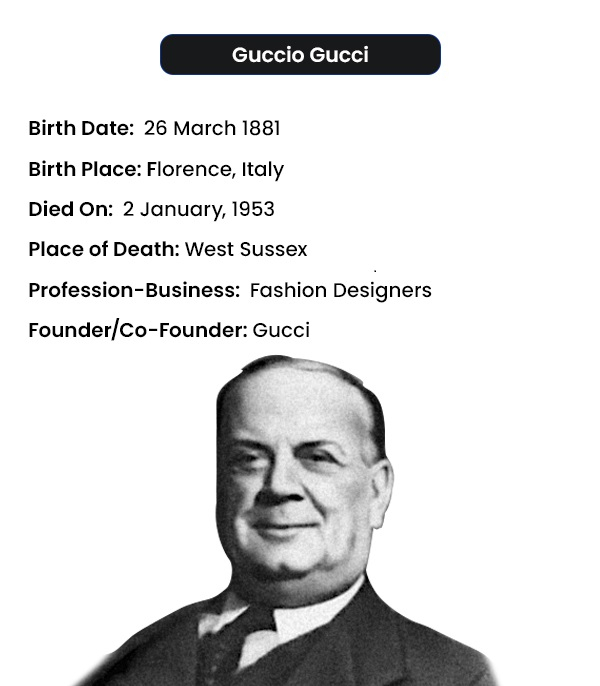

Guccio Giovanbattista Giacinto Dario Maria Gucci was born on March 26, 1881, and died on January 2, 1953. He founded Gucci, a well-known fashion brand. Soon, his company's name became well-known, and customers came to Florence from all over the globe to buy his products. Involving his sons in the management of the business, he expanded his enterprise to Rome. The company continued to grow even after his passing, and the name "Gucci" rose to prominence. Rodolfo, Maurizio, his grandson, took over as the company's general manager from him. A public limited company was immediately formed by the business. The company eventually went public. Currently, one of the most coveted luxury brands in the world is "Gucci."

On March 26, 1881, Guccio Gucci was born in Florence, Tuscany in Tuscany to Elena Santini of Lastra a Signa and leather maker Gabriello Gucci of San Miniato. Guccio Gucci began working at the Savoy Hotel in London in 1899 while still a teen. Little is known about his upbringing and the factors that led him to London. Gucci drew inspiration from both high-end hotel visitors and baggage manufacturers like H.J. Cave & Sons. He went back to Florence and began producing travel accessories and bags.
Guccio was born in a modest family in Florence, Tuscany, Kingdom of Italy. His father worked as a leather artisan in a central Italian industrial district. In 1898, Guccio departed for Europe in search of work, stopping in Paris and London. He made friends with the affluent members of British society there. The hotel's visitors' refinement and fashion sense had a big impact on him, and he was particularly taken by their bags and other accessories, many of which were produced by companies like London-based luxury leather goods label "H.J. Cave & Sons."
His father was a modest leatherworker. To make a living, Guccio went to Paris and London. The sophistication and style he witnessed while working as a lift boy at the "Savoy Hotel" significantly impacted him there. When he returned to Italy, he started working with his father to produce leather travel bags and saddles. He started creating additional accessories as the market for tackles declined in order to maintain his business. He effectively merged the sophistication he had seen overseas with Italian workmanship when he launched the family firm, "Gucci."
He started the House of Gucci as a modest, family-run leather shop in Florence in 1921. In the 1920s, he started offering saddles, leather bags, and other accouterments to horsemen. At the urging of his son Aldo, Gucci decided to open a second location for his company in Rome in 1938. When his sons joined the company, his one-man operation soon became a family business.
Gucci started a business in Milan in 1951. He wanted to keep the company small, so for almost all of his life, it only operated in Italy. The designer's sons, Aldo, Rodolfo, and Vasco Gucci, inaugurated the New York Gucci store two weeks before his passing.

He passed away on January 2, 1953, in Milan. His five sons got the business after his passing. The Gucci brand expanded with the shift in management, expanding its worldwide outlets and diversifying its product offering. The Gucci Museum, also known as the Gucci Garden, is a fashion museum in Florence that focuses on the history of the brand and its founder, Guccio Gucci.
Aida Calvelli was Gucci's wife, and the couple had five sons and one daughter between them. They were married in 1901. The child he had with his mother, Aida Calvelli, Ugo Calvelli Gucci (1899–1973), was adopted. Enzo, his son, died as a young child (1904–1913). In contrast to his daughter, who was not given a role, his sons, Ugo, Aldo, Vasco, and Rodolfo Gucci, all occupied significant positions in his business. The 1980s saw a significant family conflict brought on by intense sibling competition for control of the business. He resided in West Sussex, England, close to Rusper during his later years.
After the Kingdom of Italy, ruled by the House of Savoy, changed to the Italian Republic in 1946, Guccio Gucci, as well as Aldo's sons Giorgio Gucci, Paolo Gucci, and Roberto Gucci, and grandson Uberto Gucci, claimed the right to use an inherited, ancestral coat of arms. The Gucci coat-of-arms, as found in the Florence Archives, were modified or merged by Guccio Gucci into the Gucci company's knight emblem, which was registered as a trademark on February 4, 1955.
"Azure, three red poles edged argent; a chief or, laden to the right of an azure wheel and to the left of an azure rose," is the blazon as it is listed in the Florence Archives.
The coat-of-arms was registered as a trademark by the Gucci family in 1955, and according to court documents, records, and later judgements, the trademark passed with the 1993 sale of the Gucci corporation by Maurizio Gucci to Investcorp and succeeding business owners. The Gucci family disputes that they still have the legal right to use the ancestor Gucci's coat-of-arms, according to Uberto Gucci, the son of Roberto Gucci and the grandson of Aldo Gucci.
Guccio himself may not have received any notable honors, but his brand has.
The renowned "Jackie O" shoulder bag used by Jackie Kennedy, the silk scarves worn by Grace Kelly, and the hobo bag carried by Liz Taylor were all created by "Gucci."
Guccio started Gucci, a well-known fashion company. In order to keep his firm afloat when the demand for tackle shrank, he began producing more accessories. He founded the family business, "Gucci," by successfully fusing the sophistication he had seen abroad with Italian craftsmanship.
Customers from all over the world traveled to Florence to purchase his goods as his company's name became pretty popular across the globe. Even after his death, the business expanded, and "Gucci" became a household name.